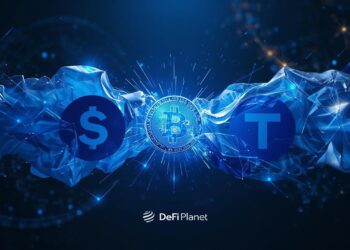At the heart of every crypto asset lies its tokenomics—the economic model defining how tokens are created, distributed, and circulated. Two major paradigms dominate token supply models: inflationary and deflationary. These models shape investor behaviour, determine long-term sustainability, and influence how ecosystems change with time. But what is the difference between inflationary and deflationary token models, and which holds the key to enduring value creation? In this article, we explore their definitions, economic theories, impacts on user behaviour, and long-term implications to uncover which model truly drives sustainable value.
What Are Inflationary Tokens?
Inflationary tokens are cryptocurrencies designed with an expanding supply, meaning that new tokens are continuously introduced into circulation over time. This increase in token supply is typically built into the protocol’s design. It is often used as a way to incentivize network participants and maintain the health and functionality of the blockchain ecosystem.
Inflationary tokens embrace ongoing issuance to support a variety of network operations. Common mechanisms for inflation include staking rewards, validator incentives, and block rewards. For example, Polkadot (DOT) and Cardano (ADA) reward users who stake their tokens or participate in network validation with newly minted coins. This serves to secure the network, encourage participation, and keep the blockchain decentralized and active.
Stellar (XLM) and Dogecoin (DOGE) also follow inflationary models, though in different ways. Stellar previously issued a fixed annual inflation rate of 1%, while Dogecoin has no maximum supply cap, continuously releasing new coins to miners as rewards. These models ensure that the networks remain functional and incentivized. Still, they also introduce the challenge of maintaining token value over time, as a growing supply can lead to dilution if not matched by demand.
What Are Deflationary Tokens?
Deflationary tokens are cryptocurrencies designed with mechanisms that reduce or strictly limit the total supply over time. Unlike inflationary tokens, which continually introduce new coins into circulation, deflationary tokens are structured to either decrease the existing supply or impose a maximum cap that cannot be exceeded. This scarcity-driven model is often used to promote long-term value appreciation and combat the effects of inflation.
There are several ways deflationary mechanisms are implemented. One of the most well-known is the hard supply cap, as seen with Bitcoin (BTC), which has a fixed maximum supply of 21 million coins. This ensures that no more than 21 million bitcoins will ever exist, creating a digital scarcity similar to precious metals like gold. Additionally, Bitcoin undergoes scheduled \”halving\” events approximately every four years, where the reward for mining new blocks is cut in half. So, is Bitcoin inflationary or deflationary? Yes, Bitcoin is deflationary, due to its capped supply and slowing emission rate.
Another common deflationary strategy is token burning, where a portion of tokens is permanently removed from circulation. Binance Coin (BNB), for example, conducts regular coin burns using a portion of the exchange’s profits to buy back and destroy BNB tokens, thereby reducing the total supply over time. This mechanism is aimed at increasing the token’s value by limiting availability as demand grows.
Cronos (CRO), the native token of the Cronos chain, also incorporates burning and supply control measures as part of its deflationary model, further strengthening tokenomics and investor appeal.
Inflationary vs. Deflationary Tokens: Key Differences
 Understanding the difference between inflationary and deflationary token models is essential for navigating the crypto space intelligently.
Understanding the difference between inflationary and deflationary token models is essential for navigating the crypto space intelligently.
Scarcity vs. Circulation: Economic Theories at Play
The debate over inflationary vs. deflationary tokens is rooted in classical economics principles, particularly those concerning scarcity, supply, and value creation. These competing philosophies shape the way different cryptocurrencies function and influence their perceived value, usability, and long-term viability.
Circulation Principle (Inflationary Tokens):
Inflationary tokens align more closely with the circulation principle in economics, which emphasizes the importance of liquidity, accessibility, and utility in a growing economy. By continuously introducing new tokens into circulation—whether through staking rewards, validator incentives, or other issuance models—these cryptocurrencies encourage more frequent transactions and foster active ecosystem participation. This model mirrors traditional fiat currencies, where controlled inflation supports economic growth by incentivizing spending and investment rather than hoarding. Inflationary tokens are designed to support scalability, infrastructure development, and a wide range of use cases within their networks, making them attractive for applications that require ongoing activity and participation.
Scarcity Principle (Deflationary Tokens):
On the other hand, the deflationary model draws from the scarcity principle, which asserts that limited supply combined with growing demand typically drives prices upward. This is the same logic that underpins the value of precious commodities like gold. When a resource is rare and difficult to obtain—but in high demand—it tends to be seen as a store of value.
Deflationary tokens such as Bitcoin (BTC), with a capped supply of 21 million, are often referred to as “digital gold” for this reason. Their design limits the rate at which new tokens can be created, and in some cases, actively reduces the circulating supply through mechanisms like burning or halving. This scarcity-based approach appeals to those who prioritize asset preservation, long-term value, and protection against inflation.
Impacts on Investor Behaviour and HODLing
- Inflationary Tokens: Designed for daily usage and active circulation, they tend to discourage long-term holding. Investors are incentivized to spend or stake them to offset dilution. This supports network participation and decentralization, but can lead to short-term speculation.
- Deflationary Tokens: Scarcity drives long-term holding behaviour (HODLing). Investors perceive them as hedges against inflation and store-of-value assets. However, excessive HODLing can reduce transaction volume and network utility.
In both cases, understanding the characteristics of an inflationary token or a deflationary token helps investors align their strategy with the token’s behaviour model.
Key Insight: The psychological aspect of token holding often ties to perceived future scarcity (deflationary) versus immediate utility and yield (inflationary).
RELATED: Bitcoin HODLing Strategy in 2025: Is Holding Still the Smartest Move?
Protocol Design and Ecosystem Stability
Inflationary Model Design:
The inflationary model in blockchain design involves the dynamic issuance of new tokens to support network growth and reward validators or stakers. This continuous creation of tokens helps fund ongoing development and ensures that participants are incentivized to remain active, which in turn sustains network operations. However, this model comes with a significant risk: if too many tokens are issued, it can lead to inflationary pressure that devalues the token. Such over-issuance may erode long-term investor confidence and harm the perceived reliability of the project.
Deflationary Model Design:
The deflationary model in blockchain design emphasizes scarcity as a key driver of value. By setting a fixed supply cap, the total number of tokens that can ever exist is limited, which can increase demand and boost value over time. This scarcity is further reinforced through burning mechanisms that permanently remove tokens from circulation, gradually reducing supply.
Additionally, deflationary models often incorporate reduced block rewards, such as Bitcoin’s halving events, which slow the rate of new token issuance. This helps extend the network’s longevity by preserving scarcity. However, this model carries a notable risk: as rewards decrease, there may be less funding available for ongoing development, and validators or miners might be discouraged from participating. If incentives drop too low, it could lead to underfunding and validator exit, ultimately jeopardizing the network’s security and long-term sustainability.
Hybrid Models:
Hybrid crypto models combine inflationary and deflationary mechanisms to strike a balance between network growth, security, and long-term value. They issue new tokens to reward validators while burning a portion of transaction fees to control supply. For example, Cosmos burns part of its transaction fees alongside inflationary staking rewards. This adaptive approach helps sustain participation, prevent oversupply, and maintain price stability in changing market conditions.
Utility vs. Store of Value
When considering utility versus store of value, the alignment of a token’s use case plays a crucial role in its design. Inflationary tokens are typically more effective for active use cases such as governance, staking, decentralized applications (dApps), and everyday transactions, where a steady or growing supply supports ongoing network activity.
For example, gaming platforms often adopt inflationary models to provide continuous in-game rewards and foster user engagement. On the other hand, deflationary tokens are generally better suited as a store of value, focusing on wealth preservation and encouraging long-term holding. Their scarcity appeals to investors looking to safeguard assets over time. Meanwhile, financial protocols might implement deflationary models to attract and retain long-term capital by emphasizing token scarcity and value preservation. Successful projects carefully align their tokenomics with their intended utility, ensuring that token design effectively supports the ecosystem’s goals and user needs.
Conclusion: Which Drives Long-Term Value?
When it comes to deciding which token model, inflationary or deflationary, truly drives long-term value, there’s no simple, one-size-fits-all answer. The impact of each depends heavily on the token’s core purpose, whether it aims to serve as a store of value or power, an everyday utility, as well as the strength of its ecosystem’s incentives and governance structures. Equally important is the long-term sustainability of the economic design behind the token.
Deflationary tokens tend to attract long-term holders and institutional investors who see them as a reliable hedge against inflation, banking on scarcity to preserve wealth. Inflationary tokens, meanwhile, fuel active network participation and foster ongoing development by rewarding users, validators, and developers alike.
In reality, the most successful projects often find a balance—blending elements of both inflationary and deflationary mechanics and tweaking supply policies to meet the evolving needs of their ecosystems. Ultimately, the true driver of lasting value isn’t simply whether a token is scarce or abundant. Instead, it lies in its ability to consistently deliver meaningful utility, uphold strong governance, and sustain resilient demand over time. This dynamic interplay is what truly builds enduring value in the crypto space.
Disclaimer: This article is intended solely for informational purposes and should not be considered trading or investment advice. Nothing herein should be construed as financial, legal, or tax advice. Trading or investing in cryptocurrencies carries a considerable risk of financial loss. Always conduct due diligence.
If you want to read more market analyses like this one, visit DeFi Planet and follow us on Twitter, LinkedIn, Facebook, Instagram, and CoinMarketCap Community.
Take control of your crypto portfolio with MARKETS PRO, DeFi Planet’s suite of analytics tools.”




















